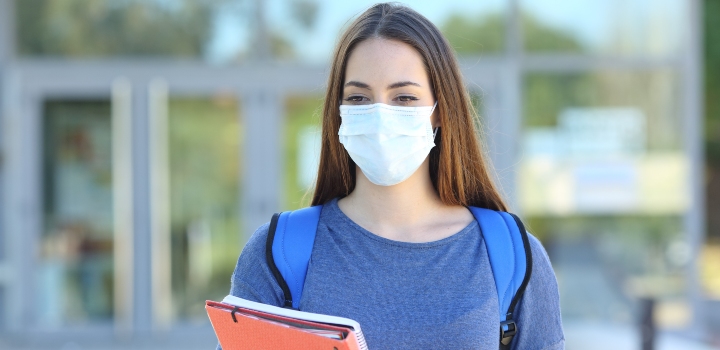The Covid-19 university challenge
By: Communications

Universities should keep their windows fully open and students shouldn’t share personal items – according to new University of East Anglia research into reducing the spread of Covid-19.
A new study sets out the ‘critical control points’ where the risks of transmission between students are greatest – including in student accommodation, shared spaces, while queueing, on work placements and during teaching.
Importantly, it highlights areas where spread of the virus could be mitigated and reduced – by measures such as handwashing, mask-wearing, two-meter social distancing, keeping windows open and avoiding sharing personal items.
It is hoped that the recommendations will help prevent the spread of Covid-19 both within universities and to the wider community.
Lead researcher and Covid-19 expert Prof Paul Hunter, from UEA’s Norwich Medical School, said: “The COVID-19 pandemic has disrupted education at all levels. And while it seems clear that shutting educational facilities can reduce the prevalence of Covid-19, the harms of closing schools, colleges and universities are unacceptable. We therefore need strategies to enable teaching to continue as safely as possible.
“University graduates go into a wide range of key worker professions, including nursing, medicine, social care and teaching so closing universities would increase existing shortages of essential qualified workers.
“And while some degree courses can be effectively delivered online, many courses depend on practical work in laboratories, using university facilities like libraries and equipment, and placement opportunities - particularly for courses in nursing and medicine.
“We wanted to find out how universities can continue to operate, in the safest way possible – for students, university staff and the wider community.”
The research team used an approach which originated in risk management of food production systems – the Hazard Analysis of Critical Control Points (HACCP) framework.
HACCP assessments have been increasingly used to assess risks related to an emerging health threats and infectious diseases.
The HACCP process involved virtual workshops and meetings amongst a HACCP team set up at UEA.
This ‘dream team’ included ‘experts from the fields of microbiology, infectious diseases, public health, environmental health, science communication, student safety and student administrative services.
They took into account different scenarios for student interactions on and off campus including teaching, social activities, accommodation arrangements and day-to-day campus activities.
A ‘hazard’ was considered to be an interaction that would provide the opportunity for the transmission of Covid-19 to another person. And these hazards were grouped into high, medium and low-risk categories.
Prof Hunter said: “We’re a campus university with a student population of over 17,000 – including more than 8,000 new starters in September 2020.
“We used the HACCP approach to identify behaviours and practices linked to typical student activities that present transmission risks.
“We identified the points where the risks of transmission are greatest – to mitigate and reduce the risk of spreading Covid-19.
“We focused on the high-risk hazards, because we wanted to produce recommendations that would do most to reduce coronavirus transmission – to keep the infection rate at a relatively low and manageable level both within the university and wider Norwich community.
“Our main concerns were around shared use of social spaces such as sports changing rooms, prayer facilities, study facilities including teaching rooms and rooms for the examination of patients for students on medical and health science courses.”
The team identified 22 high-risk critical control points and made multiple recommendations to reduce the risk in each. These include physical distancing of at least two meters, mask wearing, opening windows to increase ventilation, handwashing, sanitising shared objects and spaces,
“Each transmission opportunity can be minimised or even eliminated through careful implementation of the recommendations we propose,” said Prof Hunter.
Case study – what happened at UEA
Prof Paul Hunter said: “Here at UEA, our response to Covid-19 has had three main components, covering communications, social distancing and testing and monitoring.
“Regular communications were sent to all students about Covid-19 safety measures and the University's expectations around responsible behaviour. These were reinforced by enhanced security and monitoring of students on-campus, in accommodation and in other social settings, to discourage and prevent social gatherings that span households.
“Hand sanitiser and associated signage provided in teaching rooms and at key points in communal areas helped maintain a visible reminder of Covid-19 risk. To help ensure adequate distancing, one-way systems for navigating corridors within buildings and the narrower pathways outside on campus were introduced.
“In addition, a precautionary approach to two-meter distancing in teaching rooms was pursued, with teaching rooms at about 10 to 20 percent of their normal capacity.”
At the start of autumn term, UEA introduced an asymptomatic testing scheme in partnership with the Earlham Institute, a genomics research laboratory also located on the Norwich Research Park.
The ‘Norwich Testing Initiative’ had capacity to analyse 500 PCR tests per day. All members of the university community (students and staff) who regularly visited campus or lived there were encouraged to get tested.
Positive case students and their households were isolated for 10 days with non-symptomatic, non-positive housemates isolating for 14 days, with regular welfare support for those living off campus.
There was daily monitoring of case numbers and patterns by University Safety Services and members of the University's Executive Team, through a daily Major Operations Group meeting, to review trends and patterns and adjust the University's response as necessary.
The results
After students arrived back at UEA at the start of autumn term, the number of actively positive student cases being managed peaked at just 69 after three weeks and fell to below 25 by week six.
By December 9 only two cases had tested positive in the previous 10 days.
Of 360 cases in total detected over the first 11 weeks of monitoring, just three were members of staff involved in teaching – suggesting that the transmission reduction measures taken to prevent spread in teaching spaces were successful.
‘The COVID University Challenge: a Hazard Analysis of Critical Control Points Assessment of the Return of Students to Higher Education Establishments’ is published on the MEDRvix preprint server.
The peer reviewed paper was published in the journal Risk Analysis on June 2, 2021: https://onlinelibrary.wiley.com/doi/full/10.1111/risa.13741.
Related Articles

Employment and wellbeing often don’t correlate
Not all jobs are good jobs, and new research from the Universities of East Anglia (UEA) and Birmingham finds such work can have a negative impact on wellbeing.
Read more
Mental health disorders and alcohol misuse more common in LGB people
Lesbian, gay and bisexual (LGB) people are significantly more likely to have mental health conditions and report alcohol and drug misuse than heterosexual people according to a new study led by UCL in collaboration with the University of East Anglia and
Read more
Continued strict control measures needed to reduce new COVID-19 strains
A group of scientists is calling on governments to consider the continued use of strict control measures as the only way to reduce the evolution and spread of new COVID-19 variants.
Read more